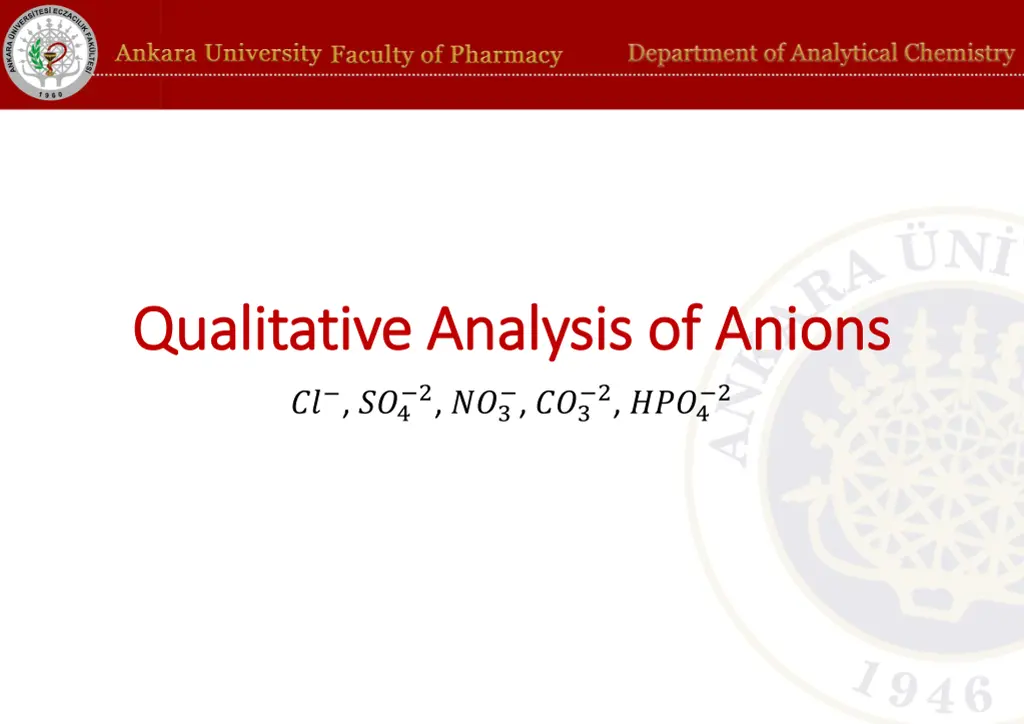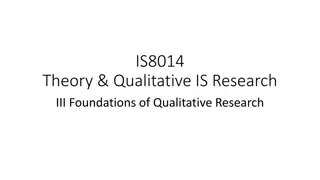
Qualitative Analysis of Anions: Identification Tests and Reactions
An overview of qualitative analysis of anions, focusing on identification tests for specific anions such as chloride and sulfate ions. Learn about the reactions involved in separating and identifying anions in chemical samples.
Download Presentation

Please find below an Image/Link to download the presentation.
The content on the website is provided AS IS for your information and personal use only. It may not be sold, licensed, or shared on other websites without obtaining consent from the author. If you encounter any issues during the download, it is possible that the publisher has removed the file from their server.
You are allowed to download the files provided on this website for personal or commercial use, subject to the condition that they are used lawfully. All files are the property of their respective owners.
The content on the website is provided AS IS for your information and personal use only. It may not be sold, licensed, or shared on other websites without obtaining consent from the author.
E N D
Presentation Transcript
Qualitative Analysis of Anions Qualitative Analysis of Anions ?? , ??4 2, ??3 , ??3 2, ???4 2
Qualitative analysis of anions Anions are negatively charged ions. When only one anion is present in sample, it can be identified with a chemical test . When they are present in a mixture, first, they are separated into groups by their precipitating agents, and then the qualitative analyses are performed. The main principle of the anion groups is the difference between their solubility products, just like the cation groups. Hovewer, the differences between the solubility products of the anion groups are low. So they cannot be separated easily, hence the systematic analysis of anions is difficult to perform. Also, the anions are much more active than the cations. ?, can be ?, ??? , ??? ?and ??? The most abundant anions, which are ?? , ??? identified in precence of each other because they have specific reactions. Since they have specific reactions, the identification tests of Cl , SO4 and PO4 , CO3 2 2, NO3 3can be performed without separation or systematic analysis.
1. Reactions of chloride ion (Cl) 1.1. With AgNO3ile Cl ion reacts with AgNO3 to precipitate as white AgCl. AgCl does not dissolve when HNO3is added to the medium. ?? + ????3 ????(?)+ ??3 2and PO4 3all react with AgNO3to precipitate as 2, CO3 In neutral solutions, Cl ,SO4 silver salts. (AgCl, Ag2CO3, Ag3PO4, Ag2SO4) When HNO3is added to them, all these silver salts except for AgCl dissolves. Which means AgCl is the only silver salt which does not dissolve with HNO3. That is why, HNO3is added to the test tube for Cl identification test. If present, the other anions cannot be precipitated as silver salts when HNO3is added. If the acidification is performed by adding HCl, the chloride anion in HCl precipitates with AgNO3even though the sample does not contain chloride. So the selection of the acidifying agent is important.
1. Reactions of chloride ion (Cl) (continued) AgCl is dissolved by forming a complex with NH3, cyanide and thiosulfate ions. ++ ?? ????(?)+ 2??3 ??(??3)2 ????(?)+ 2??? 2?++ ??(??)2 + ?? ????(?)+ 2??2?2?3 4??++ ??(?2?3)2 3+ ?? +) is destroyed with the addition of HNO3, and Diamine silver complex ( ??(??3)2 AgCl re-precipitates. ++ 2??3 + ????(?) ++ ?? + 2???3 2??4 ??(??3)2
2) 2. Reactions of sulfate ion (SO4 2.1. With BaCl2ile SO4 acidic medium. 2ion reacts with BaCl2 to precipitate as white BaSO4. BaSO4does not dissolve in 2+ ????2 ????4 (?)+ 2 ?? ??4 2,CO3 2ve PO4 3all react with BaCl2to precipitate as 2, SO3 In neutral solutions, SO4 barium. (BaSO4, BaCO3, Ba3(PO4)2, BaSO3) When an acid is added to them, all these barium salts except for BaSO4dissolves. Which means BaSO4 is the only barium salt which does not dissolve in acidic medium. That is why, HNO3or HCl is added to the test tube for??? present, the other anions cannot be precipitated as barium salts when acid is added. If the acidification is performed by adding H2SO4, the sulfate anion in H2SO4 precipitates with BaCl2 even though the sample does not contain sulfate. So the selection of the acidifying agent is important. ?identification test. If
2) 2. Reactions of sulfate ion (SO4 2.2. With AgNO3 When AgNO3is added to concentrated solutions of sulfate, Ag2SO4precipitates as white crystallines. 2+ 2????3 ??2??4 (?)+ 2??3 ??4 Ag2SO4dissolves in mineral acids (HNO3, HCl).
) 3. Reactions of nitrate ion (NO3 3.1. With Diphenylamine Diphenylamine, which is a colorless reactant, oxidizes to diphenyl benzidine violet, which has a blue-violet color, in presence of an oxidant such as NO3 This reaction occurs in acidic medium. Diphenylamine solution which is prepared by dissolving solid diphenylamine in concentrated H2SO4is used for the identification of nitrate. When one or two drops of diphenylamine solution is added to nitrate solution, a blue-violet colour appears on the contact surface of two liquids. This test is performed in a watch glass because it is a exotermic reaction. , HNO2, FeCl3.
) 3. Reactions of nitrate ion (NO3 3.2. With Fe+2(FeSO4) (Brown ring test) In acidic medium, FeSO4reduces nitrate ion to nitric oxide(NO) . NO forms a brown complex with the excessive Fe+2. The name of this complex is Iron II nitrosyl. + H2SO4 HSO4 + HNO3 NO3 6FeSO4+ 2HNO3+ 3H2SO4 3Fe2(SO4)3+ 2NO + 4H2O FeSO4+ NO Fe(NO) SO4 (Iron II nitrosyl (Iron II nitrosyl sulfate sulfate) )
2) 4. Reactions of carbonate ion (CO3 4.1. With acid (HCl, H2SO4, CH3COOH) addition CO3 2 ion reacts with dilute acids to give water, CO2 and salt (or anion). 2+ 2??3???? 2??3??? + ?2? + ??2(?) ??3 The releasing gas is introduced to Ca(OH)2 or Ba(OH)2 solution. Formation of the cloudy-milky precipitate proves that the releasing gas is CO2. ??(??)2+ ??2(?) ????3(?)+ 4H2O In this laboratory, the formation of colourless gas bubbles is enough for the identification of CO3 2.
2) 4. Reactions of carbonate ion (CO3 4.2. With BaCl2 2 ion reacts with BaCl2 to precipitate as white BaCO3. CO3 2+ ????2 ????3 (?)+ 2 ?? ??3 BaCO3 dissolves in mineral acids (HNO3, HCl) by releasing CO2. ????3(?)+ 2?+ ??+2+ ?2? + ??2(?)
2) 4. Reactions of carbonate ion (CO3 4.3. With AgNO3 2 ion reacts with AgNO3 to precipitate as white Ag2CO3. CO3 2+ 2????3 ??2??3(?)+ 2??3 ??3 Ag2CO3 dissolves in mineral acids (HNO3, HCl) by releasing CO2. ??2??3(?)+ 2?+ 2??++ ?2? + ??2(?)
3) 5. Phosphate (PO4 There are three type of phosporic acids. 1. H3PO4 2. H4P2O7 3. HPO3 Orthophosphoric acid Pyrophosphoric acid Metaphosphoric acid H3PO4 is a tribasic acid and can produce 3 different salts with NaOH. I. NaH2PO4 Primary orthophosphate II. Na2HPO4 Secondary orthophosphate (orthophosphate) III. Na3PO4 Tertiary orthophosphate
2) 5. Reactions of orthophosphate ion (HPO4 5.1. With ammonium molybdate (molybdate ion): HPO4 phosphomolybdate in precence of HNO3. 2ion reacts with molybdate to precipitate as yellow ammonium ++ 23??3 2+ 12(??4)2???4+ 23???3 (??4)3(???3)12??4(?)+ 21??4 In order to speed up the formation of ammonium phosphomolybdate precipitate the solution may be heated to 40 C in water bath , or ammonium nitrate may be added to the test tube. + 12?2? ???4
2) 5. Reactions of orthophosphate ion (HPO4 5.2. With AgNO3 Orthophosphate ion reacts with AgNO3 to precipitate as yellow Ag3PO4. + ???3 2+ 3????3 ??3??4(?)+ 2??3 ???4 Ag3PO4 dissolves with the addition of NH3 or HNO3. ??3??4(?)+ 3?+ 3??++ ?3??4
2) 5. Reactions of orthophosphate ion (HPO4 5.3. With BaCl2 Orthophosphate ion reacts with BaCl2 to precipitate as white amorphous BaHPO4. 2+ ????2 ?????4(?)+ 2 ?? ???4 BaHPO4 dissolves with the addition of acetic acid and mineral acids. ?????4(?)+ 2?+ ??+2+ ?3??4 If H2SO4 is used for the acidification, the sulphate in the acid reacts with barium to precipitate as BaSO4 . Because both BaSO4 and BaHPO4 are white precipitates, the identification of orthophospate cannot be performed correctly.
References Analitik Kimya Pratikleri Kalitatif Analiz, F. Onur (Ed.), A. . Eczac l k Fak ltesi Yay nlar No. 103, 2012.






















